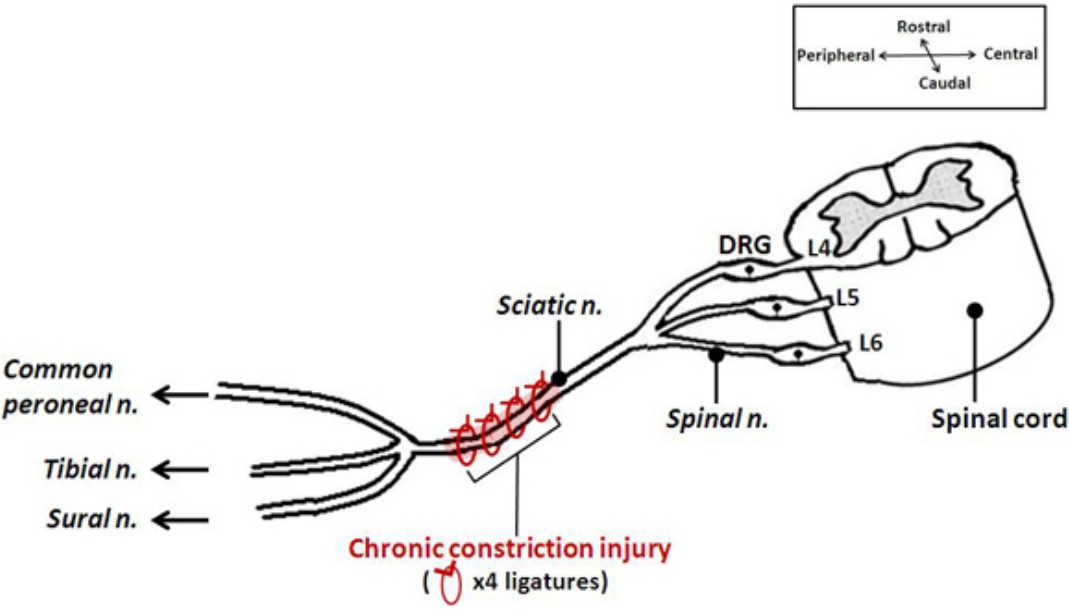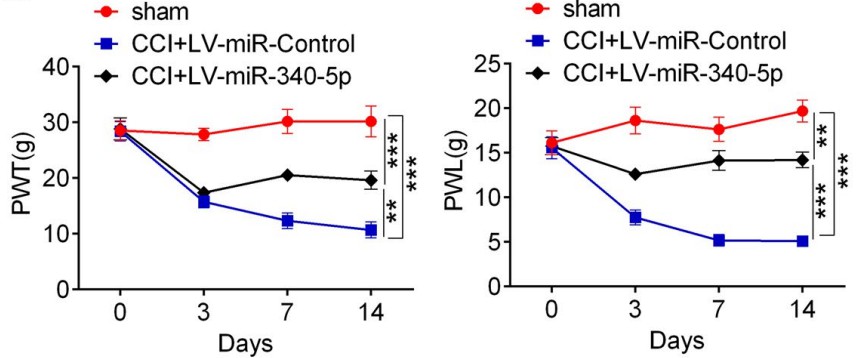Chronic Constriction Injury (CCI) Model
Creative Bioarray offers the widely recognized surgical model of neuropathic pain, the Chronic Constriction Injury (CCI) model, to facilitate the preclinical evaluation of analgesic drug efficacy for our clients. This model is meticulously designed to simulate the complex pathophysiology of neuropathic pain, enabling researchers to explore the mechanisms underlying this condition and to assess the potential of novel therapeutic interventions. Through our services, clients gain access to a reliable and reproducible platform for testing the efficacy of analgesics, contributing to the advancement of pain management therapies.
Chronic neuropathic pain, a consequence of injury to the central or peripheral nervous system, is a pervasive and incapacitating disorder. Its manifestations encompass spontaneous sensations such as tingling, burning, or electric shock-like pain, dysesthesia, paresthesia, allodynia (pain elicited by typically non-noxious stimuli), and hyperalgesia (an amplified response to painful stimuli). To investigate chronic neuropathic pain, various animal models simulating peripheral nerve injury have been engineered, among which Bennett and Xie's unilateral sciatic nerve CCI model is one of the most extensively employed.
Our Chronic Constriction Injury (CCI) Model
- Available Animal
Rat
- Modeling Method
After anesthetization, the left sciatic nerves of rats are exposed. In the CCI group, four chromic gut sutures are tied loosely around the nerve at four segments with approximately 1-mm intervals. In the sham group, the sciatic nerves are exposed without ligation.
 Fig. 1 A schematic illustrating the positioning of the ligatures in the CCI model. (Austin et al, 2012)
Fig. 1 A schematic illustrating the positioning of the ligatures in the CCI model. (Austin et al, 2012)
- Endpoints
- Clinical observation
- Body weight
- Behavioral tests: Von Frey test, Hot plate test, etc.
- qPCR or Western blot
- Histology analysis
- Other customized endpoints
Example Data
 Fig. 2 Paw withdrawal threshold (PWT) and paw withdrawal latency (PWL) were assessed at day 0, 3, 7, 14. (Gao et al. 2019)
Fig. 2 Paw withdrawal threshold (PWT) and paw withdrawal latency (PWL) were assessed at day 0, 3, 7, 14. (Gao et al. 2019)
 Fig.3 H&E staining was performed to detect inflammation response of nerve fiber. (Gao et al. 2019)
Fig.3 H&E staining was performed to detect inflammation response of nerve fiber. (Gao et al. 2019)
Furthermore, we also provide other neuropathic pain models that maybe you are interested in:
- Diabetes-Induced Neuropathic Pain Model
- Chemotherapy-Induced Neuropathic Pain Model
- Spared Nerve Injury (SNI) Model
- Partial Sciatic Nerve Ligation (PSL/PSNL) Model
- Spinal Nerve Ligation (SNL) Model
Quotation and Ordering
Creative Bioarray boasts a team of highly qualified and experienced scientists dedicated to providing comprehensive contract drug efficacy evaluation services. Our commitment to excellence ensures that we deliver timely, high-quality results, enabling our clients to make informed decisions in their drug development processes. If you are interested in our services, please feel free to contact us or submit an inquiry to us directly.
References
Creative Bioarray offers the widely recognized surgical model of neuropathic pain, the Chronic Constriction Injury (CCI) model, to facilitate the preclinical evaluation of analgesic drug efficacy for our clients. This model is meticulously designed to simulate the complex pathophysiology of neuropathic pain, enabling researchers to explore the mechanisms underlying this condition and to assess the potential of novel therapeutic interventions. Through our services, clients gain access to a reliable and reproducible platform for testing the efficacy of analgesics, contributing to the advancement of pain management therapies.
Chronic neuropathic pain, a consequence of injury to the central or peripheral nervous system, is a pervasive and incapacitating disorder. Its manifestations encompass spontaneous sensations such as tingling, burning, or electric shock-like pain, dysesthesia, paresthesia, allodynia (pain elicited by typically non-noxious stimuli), and hyperalgesia (an amplified response to painful stimuli). To investigate chronic neuropathic pain, various animal models simulating peripheral nerve injury have been engineered, among which Bennett and Xie's unilateral sciatic nerve CCI model is one of the most extensively employed.
Our Chronic Constriction Injury (CCI) Model
- Available Animal
Rat
- Modeling Method
After anesthetization, the left sciatic nerves of rats are exposed. In the CCI group, four chromic gut sutures are tied loosely around the nerve at four segments with approximately 1-mm intervals. In the sham group, the sciatic nerves are exposed without ligation.
 Fig. 1 A schematic illustrating the positioning of the ligatures in the CCI model. (Austin et al, 2012)
Fig. 1 A schematic illustrating the positioning of the ligatures in the CCI model. (Austin et al, 2012)
- Endpoints
- Clinical observation
- Body weight
- Behavioral tests: Von Frey test, Hot plate test, etc.
- qPCR or Western blot
- Histology analysis
- Other customized endpoints
Example Data
 Fig. 2 Paw withdrawal threshold (PWT) and paw withdrawal latency (PWL) were assessed at day 0, 3, 7, 14. (Gao et al. 2019)
Fig. 2 Paw withdrawal threshold (PWT) and paw withdrawal latency (PWL) were assessed at day 0, 3, 7, 14. (Gao et al. 2019)
 Fig.3 H&E staining was performed to detect inflammation response of nerve fiber. (Gao et al. 2019)
Fig.3 H&E staining was performed to detect inflammation response of nerve fiber. (Gao et al. 2019)
Furthermore, we also provide other neuropathic pain models that maybe you are interested in:
- Diabetes-Induced Neuropathic Pain Model
- Chemotherapy-Induced Neuropathic Pain Model
- Spared Nerve Injury (SNI) Model
- Partial Sciatic Nerve Ligation (PSL/PSNL) Model
- Spinal Nerve Ligation (SNL) Model
Quotation and Ordering
Creative Bioarray boasts a team of highly qualified and experienced scientists dedicated to providing comprehensive contract drug efficacy evaluation services. Our commitment to excellence ensures that we deliver timely, high-quality results, enabling our clients to make informed decisions in their drug development processes. If you are interested in our services, please feel free to contact us or submit an inquiry to us directly.
References
- Gao, L., et al. MicroRNA-340-5p relieved chronic constriction injury-induced neuropathic pain by targeting Rap1A in rat model. Genes Genomics. 2019;41(6):713-721.
- Austin, P.J., et al. Chronic constriction of the sciatic nerve and pain hypersensitivity testing in rats. JoVE (Journal of Visualized Experiments), 2012 (61): e3393.
Explore Other Options

